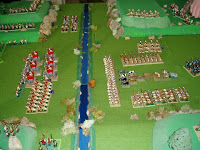A scenario mentioned in a previous post. The number of Gauls is not mentioned and historic sources seem to have been misplaced, though as the victorious Carthaginian
commander I should- in the style of the Ancients - estimate them at 200,000. In truth I think it was something like 250 infantry and 32 cavalry
In the late-summer of 218BC Hannibal and his Carthaginian army began the ascent into the Alps. Passing along the valley of the Drome he came into the Gorge des Gaz at the base of the Col de Grimone. Here he found his way blocked by hostile Gauls of the Allobroge tribe who hurled rocks down onto the convoy as it passed by until Hannibal and his cavalry descended on them from higher ground and drove them off. Later Hannibal was attacked again – probably by Quariates, a Ligurian tribe – in the gorge of the Guil. Here the tribesmen showered rocks down on the Carthaginians before charging into the rearguard, which held firm.
This scenario is an amalgam of both these events.
Hannibal’s army will consist of:
Hannibal
Marhabal
2 x 40 figure Carthaginian spearmen
1 x 40 fig Libyan spearmen
(All close order)
3 x 30 fig Spanish Scutari (Based, like the Gauls, six figs to an 8 fig base to give looser order than above)
2 x 12 Balearic slingers
2 x 12 Spanish caetrati javelins
1 x 12 Libyan javelins
(All above are skirmish order)
1 x 16 Carthaginian close order cavalry
1 x 16 Spanish close order cavalry
2 x 16 Numidian light cavalry
1 x 16 Spanish light cavalry
6 Elephants
Baggage mules/oxen/horses.
The terrain: a narrow valley between lofty peaks with a river crossing the table to provide added problems. Vegetation is minimal but he slopes are dotted with rocks that can be rolled down on the enemy by any unit in base-to-base contact with them.
Objective: Carthaginians have to get their baggage from one end of the table to the other (I’d suggest we play length ways on a 9 foot by 6 foot table). The Gauls must stop them.
Special rules:
The mountain slopes (that is any elevated area above the valley) do not affect the movement rates of light troops or troops in loose order (Scutari and Gauls).
Light cavalry may move on the slopes at reduced rate of 25cms per move.
Heavy cavalry may move at 20cms per move, 25cms if charging.
Heavy infantry moves at 10cms, 12cms when charging.
Ascending from one level to another reduces all troop movement by 25%.
Elephants and baggage may not leave the valley.
Rock rolling. Rocks travel downwards in a straight line 3xD6cms throwing 1xd20 if they hit skirmishers, 2 x D20 for loose order troops and close order troops, cavalry and baggage. An additional D20 is thrown if the unit struck is more than 2 ranks deep. Rocks will travel the full length of their move rolling for hits against any units the pass through on the way.
Elephants effect on Gauls: The Gauls had never seen elephants and seem to have been sent into a panic by them. Gauls cannot come with 20cms of an elephant and must move out of that range if one approaches.
Stephen Caddy povides this brief summary of the action:
It was an unusual encounter with no real winners. Hannibal Harry managed
to get most of his heavy troops, elephants and all his baggage
through the badlands of the Alpine passes. Celtic Caddy [it is a
Cornish surname afterall] managed to inflict terrible losses on the
Carthaginians and Hannibal's life was in danger several times but his
life was charmed [after he hid among the elephants].
We concluded that Hannibal would probably have to spend his treasure
from the baggage train recruiting the very men who had denuded his
force of so many Spaniards and Numidians.
It was a Hollywood epic complete with triggering rockslides which did
a little damage.
It was the first time these Celts had seen elephants [hard to imagine
their reaction at the time] and so they could not remain within 20cm
of the beasts which with a 15cm javelin range made life interesting.
Getting away [or not!] when the elephants moved quicker was exciting
too.


No comments:
Post a Comment